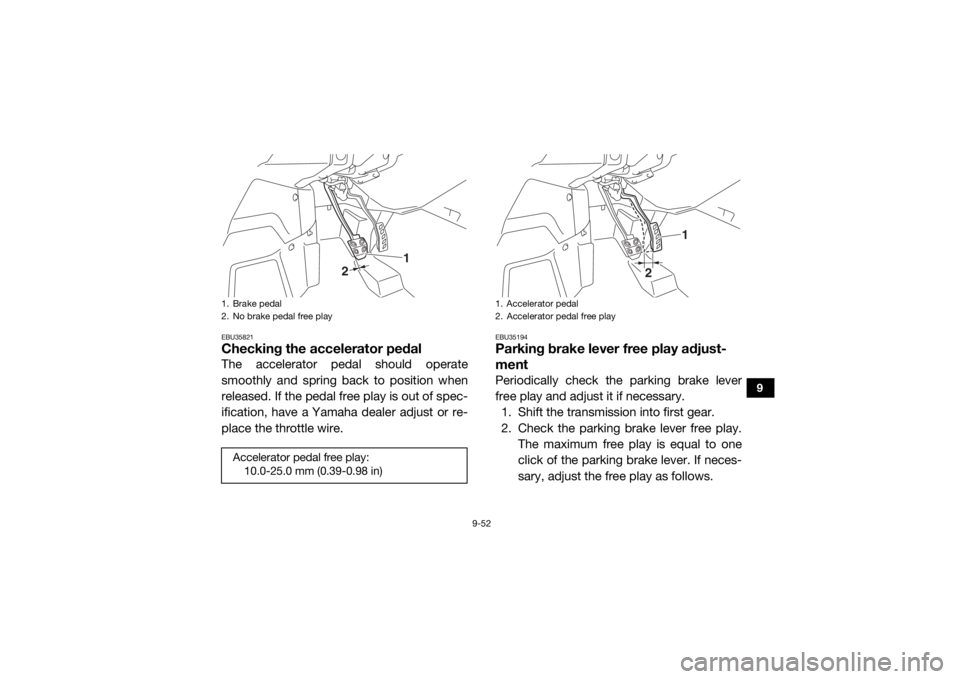Shift YAMAHA YXZ1000R SS 2020 Owner's Guide
[x] Cancel search | Manufacturer: YAMAHA, Model Year: 2020, Model line: YXZ1000R SS, Model: YAMAHA YXZ1000R SS 2020Pages: 212, PDF Size: 9.36 MB
Page 120 of 212

8-15
8
Braking
When slowing down or stopping, take your
foot off the accelerator pedal and press the
brake pedal smoothly. Abrupt or improper
use of the brakes can cause the tires to lose
traction, reducing control of the vehicle and
increasing the possibility of an accident.
Braking ability is affected by type of terrain. In
most cases, gradual application of the brakes
is more effective than abrupt braking, partic-
ularly on loose surfaces, such as gravel. Al-
ways allow for greater braking distance on
rough, loose, or slippery surfaces.
Engine compression braking will also help
slow the vehicle down. With the transmission
still in gear, take your foot off the accelerator
and allow the drivetrain and engine to absorb
vehicle speed. Downshift as necessary. Ap-
plication of the brakes provides additional
stopping power. Leaving the vehicle
Do not get out of the vehicle while the engine
is running. Take the key with when you leave
the vehicle. There is a serious risk of injury or
death because:
Children or other unauthorized persons
may attempt to operate the vehicle.
Objects tossed into the vehicle may strike
the shift lever and accidently engage the
transmission.
The parking brake may not keep the vehicle
from moving.
Parking on a flat area
Even when parking on a seemingly flat area, it
is good practice to leave the transmission in
gear to prevent the vehicle from rolling.
Therefore, shift into first or reverse gear, stop
the engine and always apply the parking
brake.UBAS7AE0.book Page 15 Wednesday, June 19, 2019 11:51 AM
Page 121 of 212

8-16
8
Parking on a slope
The parking brake is located on the rear drive
shaft. When the drivetrain is in “2WD” mode,
only the rear wheels will be locked. Therefore,
switch the drive mode to “DIFF LOCK” before
stopping the engine to lock all four wheels
when parking. In addition to the parking
brake, leave the transmission in gear to help
prevent the vehicle from rolling.
If you park on a hill that is too steep, the vehi-
cle may roll out of control. Never park on hills
that are so steep you cannot walk up them
easily. If you must park on an incline, follow
these instructions:1. First, bring the vehicle to a stop and con- tinue to apply the brake pedal.
2. Switch the drive mode to “DIFF LOCK”
and shift into first gear when parking up-
hill, or reverse gear when parking down-
hill.
TIPYou may need to turn the steering wheel left
and right to help the differential lock into pla-
ce. 3. Stop the engine (turn the key to “ ”[off]).
4. With the brake pedal still being applied, set the parking brake.
5. Finally, get out of the vehicle and block
the front and rear wheels with rocks or
other objects.
Loading
Be aware that vehicle load includes the total
combined weight of the operator, passenger,
any installed accessories, and any luggage or
cargo brought on board or stored in the cargo
bed. Make sure that the gross vehicle weight
(vehicle load plus weight of the vehicle itself)
never exceeds 1065 kg (2348 lb).
UBAS7AE0.book Page 16 Wednesday, June 19, 2019 11:51 AM
Page 123 of 212

8-18
8
sense and remember that some hills are too
steep for you to climb or descend. Use proper
driving techniques to avoid rearward, for-
ward, or sideways rollovers on hills and
slopes.
Drive straight up and down inclines, not
across them. If crossing a hill is unavoidable,
drive slowly. Turn downhill immediately if you
feel the vehicle may tip.
If you think or feel the vehicle may tip or
roll:
Brace yourself by pressing your feet firmly
on the floorboard and keep a firm grip on
the steering wheel or passenger handhold.
Do not put your hands or feet outside of the
vehicle for any reason.
Uphill
Do not attempt to climb hills until you have
mastered basic maneuv ers on flat ground.
Drive straight up hills, and avoid crossing the
side of a hill, which increases your risk of roll- over. Practice first on gentle slopes before at-
tempting steeper hills. Always check the
terrain carefully before attempting any hill.
To climb a hill, you need traction, momentum,
and steady throttle. For more traction and
control for climbing steeper and/or rougher
slopes, shift into low gear and select “4WD”
or “DIFF LOCK”. Travel fast enough to main-
tain momentum, but not so fast that you can-
not react to changes in the terrain as you
climb.
Slow down when you reach the crest of the
hill if you cannot see clearly what is on the
other side – there could be another person, an
obstacle, or a sharp drop-off.
If you start to lose traction or momentum
when climbing, and decide you will be unable
to continue, use the brakes to stop. Do not at-
tempt to turn the vehicle around. With your
foot on the brake pedal, look behind you and
plan your descent. Shift the transmission into
reverse so you can use engine braking to
slow your descent. Release the brake, andUBAS7AE0.book Page 18 Wednesday, June 19, 2019 11:51 AM
Page 124 of 212

8-19
8
then begin to coast down the hill. Use engine
braking as much as possible, gently applying
the brakes when necessary.
Downhill
Check the terrain carefully before going
downhill. When possible, choose a path that
lets you drive your vehicle straight downhill.
Choose your path carefully and drive slowly
enough to be able to react to obstacles that
you encounter.
For more traction and control, before going
down steeper and/or rougher slopes, shift
into low gear and select “4WD” or “DIFF
LOCK”. Engine braking will help you go
downhill slowly. Go as slowly as possible. If
you begin to go too fast, apply the brakes
gently. Avoid hard application of the brakes,
which could cause the vehicle to slide.If you are sliding or skidding, try to steer in the
direction the vehicle is sliding, to regain con-
trol. For example, if you feel the back of the
vehicle start to slide to your right, steer to the
right.
If you must turn on the hill to avoid an obsta-
cle, do so slowly and carefully. If the vehicle
starts to tip, immediately steer in the downhill
direction if there are no obstacles in your
path. As you regain proper balance, gradually
steer again in the direction you want to go.
Rough terrain
Operation over rough terrain should be done
with caution.
Look for and avoid obstacles that could
cause damage to the vehicle or could lead
to a rollover or accident.
Do not drive in a way that will get the vehicle
airborne, as injury, loss of control, and
damage to the vehicle could occur.UBAS7AE0.book Page 19 Wednesday, June 19, 2019 11:51 AM
Page 178 of 212

9-51
9
suddenly, have a Yamaha dealer check and
repair the vehicle before any further opera-
tion.EBU36550Brake and YCC-S clutch fluid replace-
mentComplete fluid replacement should be done
only by trained Yamaha service personnel.
Have a Yamaha dealer replace the following
components during periodic maintenance or
when they are damaged or leaking.
Replace the oil seals every two years.
Replace the brake and YCC-S clutch hoses
every four years.EBU36540YCC-S clutchThis model is equipped with a hydraulic
clutch, therefore, it is necessary to check the
YCC-S clutch fluid level and check the hy-
draulic system for leak age before each drive.
If the YCC-S clutch plates wear out, shifting
becomes rough or clutch slippage will occur, causing poor acceleration. If any of the above
occurs, have a Yamaha dealer check the
YCC-S clutch.
EBU32531Checking the brake pedalHave a Yamaha dealer check the brakes at
the intervals specified in the periodic mainte-
nance chart. There should be no free play in
the brake pedal. The brakes should operate
smoothly and there should be no brake drag.
If the brakes feel soft or spongy, this could in-
dicate air in the brake system. Have a
Yamaha dealer check the brake system if necessary.
UBAS7AE0.book Page 51 Wednesday, June 19, 2019 11:51 AM
Page 179 of 212

9-52
9
EBU35821Checking the accelerator pedalThe accelerator pedal should operate
smoothly and spring back to position when
released. If the pedal free play is out of spec-
ification, have a Yamaha dealer adjust or re-
place the throttle wire.
EBU35194Parking brake lever free play adjust-
mentPeriodically check the parking brake lever
free play and adjust it if necessary.1. Shift the transmission into first gear.
2. Check the parking brake lever free play.
The maximum free play is equal to one
click of the parking brake lever. If neces-
sary, adjust the free play as follows.
1. Brake pedal
2. No brake pedal free playAccelerator pedal free play:10.0-25.0 mm (0.39-0.98 in)
1
2
1. Accelerator pedal
2. Accelerator pedal free play
2
1
UBAS7AE0.book Page 52 Wednesday, June 19, 2019 11:51 AM
Page 206 of 212

11-5
11
Meter lighting:LED
Neutral indicator light: LED
High beam indicator light:
LED
Reverse indicator light: LED
Coolant temperature warning light: LED
Parking brake indicator light:
LED
Engine trouble warning light: LED
Differential gear lock indicator light: LED
EPS warning light:
LED
Helmet reminder light: 0.8 W
Seat belt reminder light: 0.8 W
Shift timing indicator light:
LED
Half clutch indicator light: LED
Launch system indicator light: LED
YCC-S system warning light:
LED
Fuses:Main fuse:50.0 A
Fuel injection system fuse:
15.0 A
EPS fuse: 40.0 A
Headlight fuse: 15.0 A
Signaling system fuse:
10.0 A
Ignition fuse: 15.0 A
Auxiliary DC jack fuse: 10.0 A
Accessory fuse:
15.0 A
YCC-S motor control fuse: 30.0 A
YCC-S motor control fuse_2: 30.0 A
Backup fuse:
10.0 A
Four-wheel-drive motor fuse: 10.0 A
Radiator fan motor fuse: 30.0 A
Sub radiator fan motor fuse:
30.0 A
UBAS7AE0.book Page 5 Wednesday, June 19, 2019 11:51 AM
Page 209 of 212

13-1
13
INDEX
AAccelerator pedal ......................................................... 5-21
Accelerator pedal, checking ........................................ 9-52
Accelerator pedal, Pre-operation check ........................ 6-6
Air filter ......................................................................... 9-41
Air filter case hoses, cleaning ...................................... 9-45
Auxiliary DC jack .......................................................... 5-49
Axle boots .................................................................... 9-38BBasic guide for safe use ................................................ 8-1
Battery, Periodic maintenance .................................... 9-60
Bead lock, checking and tightening (equipped models) ..................................................... 9-58
Brake and YCC-S clutch fluid levels, checking ........... 9-49
Brake fluid, replacing ................................................... 9-51
Brake light switch ........................................................ 9-54
Brake pedal .................................................................. 5-22
Brake pedal, checking ................................................. 9-51
Brakes, Periodic maintenance ..................................... 9-47
Brakes, Pre-operation check ......................................... 6-3
Brake/tail light .............................................................. 9-69CCable, inspecting and lubrication ................................ 9-54
Cargo bed .................................................................... 5-31
Cleaning ....................................................................... 10-1
Control cables, Pre-operation check ............................. 6-8
Coolant, Periodic maintenance ................................... 9-36
Coolant, Pre-operation check ........................................ 6-6
Coolant temperature warning light ................................ 5-4 Cup holders ................................................................. 5-30
DData recording, vehicle ................................................ 12-1
Differential gear lock indicator light ............................... 5-3
Differential gear oil, Periodic maintenance .................. 9-34
Differential gear, Pre-operation check ........................... 6-6
Doors ........................................................................... 5-25
Drive mode, selecting .................................................. 7-10
Driver seat position ...................................................... 5-27
Drive select lever and shift paddles ............................. 5-24
Drive select lever and shift paddles, Pre-operation
check ........................................................................... 6-7
Drive shaft universal joint, lubrication .......................... 9-56
Drivetrain icon ................................................................ 5-3
Dynamic clutch engagement ......................................... 7-7EEngine break-in .............................................................. 7-1
Engine oil and oil filter, Periodic maintenance ............. 9-18
Engine oil, Pre-operation check .................................... 6-5
Engine trouble warning light .......................................... 5-5
EPS warning light .......................................................... 5-5FFinal gear oil, Periodic maintenance ............................ 9-31
Final gear, Pre-operation check .................................... 6-6
Fittings and fasteners, Pre-operation check ................. 6-8
Flag pole bracket ......................................................... 5-32
Four–wheel drive knob (On–Command 4WD) ............. 5-21
Front and rear brake pads, checking .......................... 9-48
Fuel, Pre-operation check ............................................. 6-3
Fuel tank cap ............................................................... 5-25
Fuse, replacing ............................................................ 9-65
UBAS7AE0.book Page 1 Wednesday, June 19, 2019 11:51 AM
Page 210 of 212

13-2
13
GGlove compartment ..................................................... 5-29HHalf clutch indicator light ............................................... 5-6
Headlight beam, adjusting ........................................... 9-68
Headlights .................................................................... 9-67
Helmet reminder light .....................................................5-9
High beam indicator light ............................................... 5-3
Hood ............................................................................ 9-11IIdentification numbers ................................................... 1-1
Indicator lights and warning lights ................................. 5-2
Instruments, lights and switches, Pre-operation check ........................................................................... 6-8
Interior lights (equipped models) ................................. 9-69
Interior light switch (equipped models) ........................ 5-20JJump-starting ............................................................... 9-63LLabel locations ............................................................... 2-1
Launch system indicator light ........................................ 5-7
Launch system operation ............................................... 7-7
Light switch .................................................................. 5-19
Loading ........................................................................7-12MMain switch .................................................................... 5-1
Maintenance and lubrication chart ................................9-6
Maintenance chart, emission control system ................ 9-4
Maintenance charts ....................................................... 9-4
Model label ..................................................................... 1-1
Multi-function meter unit .............................................. 5-10
NNeutral indicator light ..................................................... 5-2OOwner’s Manual and tool kit .......................................... 9-2PPanels .......................................................................... 9-11
Parking ......................................................................... 7-12
Parking brake indicator light .......................................... 5-3
Parking brake lever ...................................................... 5-22
Parking brake lever free play, adjusting ....................... 9-52
Parking brake pads, checking ..................................... 9-48
Passenger handhold, Pre-operation check ................... 6-7
Pedal, lubrication ......................................................... 9-54RRear knuckle upper and lower pivot, lubrication ......... 9-56
Reverse indicator light ................................................... 5-2SSafety information .......................................................... 3-1
Seat belt reminder light .................................................. 5-9
Seat belts ..................................................................... 5-28
Seat belts, Pre-operation check .................................... 6-7
Seats ............................................................................ 5-25
Shifting and reverse driving ........................................... 7-3
Shift light ........................................................................ 5-4
Shock absorbers, front ................................................ 5-32
Shock absorbers, rear ................................................. 5-41
Spark arrester, cleaning ............................................... 9-46
Spark plugs, checking ................................................. 9-39
Specifications .............................................................. 11-1
Stabilizer bushes, checking ......................................... 9-55
Starting the engine ......................................................... 7-2
UBAS7AE0.book Page 2 Wednesday, June 19, 2019 11:51 AM